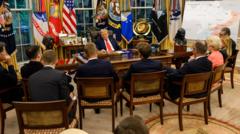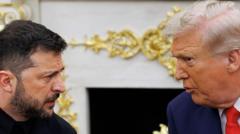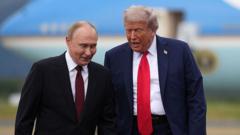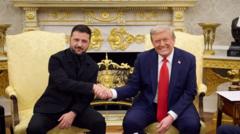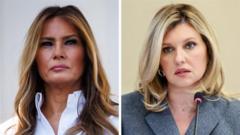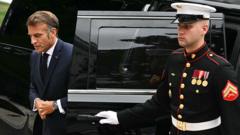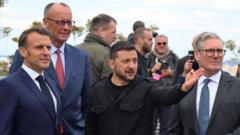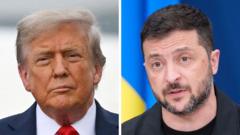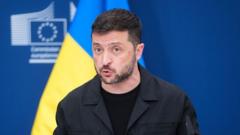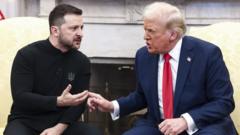Zelensky's recent meeting with Trump emphasizes diplomatic decorum while highlighting the complexities of the Ukraine conflict, aiming to secure vital military support for his nation.
Zelensky Engages in Diplomatic Tact with Trump Amid Ongoing Tensions

Zelensky Engages in Diplomatic Tact with Trump Amid Ongoing Tensions
Ukrainian President Volodymyr Zelensky navigates his latest White House visit seeking security assurances and support for Ukraine against Russian aggression.
In a stark contrast to past encounters, Ukrainian President Volodymyr Zelensky left the White House without incident, having successfully projected a cooperative image during his meeting with U.S. President Donald Trump. Gone were the tense exchanges from their previous interaction in February; this time, both leaders seemed focused on maintaining a diplomatic front, even amidst significant ideological differences.
Dressed in a stylish collared suit, Zelensky was met with compliments from Trump, and his repeated expressions of gratitude seemed to signal a desire for a productive dialogue. However, Zelensky's initial reticence suggested he was cautious about broaching topics that might clash with Trump's views, particularly regarding the ongoing war in Ukraine.
The dialogue shifted when Zelensky joined Trump and European leaders, including German Chancellor Friedrich Merz and French President Emmanuel Macron, before the press. While both European leaders endorsed a ceasefire as the next step towards peace, Trump countered that such measures should precede more robust negotiations. Zelensky's silence on this contentious issue was telling.
Behind closed doors, the discussions likely revolved around security guarantees for Ukraine and the potential for a direct dialogue with Russian President Vladimir Putin. Though specifics of these security assurances remained undisclosed, Zelensky categorized them as a critical foundation for achieving peace. He mentioned the possibility of a $90 billion arms deal with the U.S., which would include advanced weaponry for Ukraine as well as the U.S. commitment to purchase some Ukrainian-produced drones.
While no formal agreement was finalized during this visit, Zelensky expressed optimism that a deal could be reached within the next ten days. He indicated his openness to meeting directly with Putin, with Trump possibly participating in negotiations should Moscow agree to the proposal.
Interestingly, the leaders steered clear of discussing any potential territorial concessions from Ukraine, which remains a sensitive topic. To illustrate Ukraine's position, Zelensky shared a map with Trump, revealing that Russia has taken less than 1% of Ukrainian territory in the past 1,000 days—a fact he claimed was surprising to the American leader and appeared to soften Trump's stance.
Conclusively, Zelensky described the meeting as "warm," reflecting aspirations for a positive diplomatic relationship. The Ukrainian president's strategic restraint and hope to align America more closely with European perspectives on the war suggest a broader aim: to secure additional time and resources for Ukraine as the conflict with Russia persists. Despite this diplomatic maneuvering, the status quo remains tenuous, leaving both nations and their leaders in a delicate balancing act.
Dressed in a stylish collared suit, Zelensky was met with compliments from Trump, and his repeated expressions of gratitude seemed to signal a desire for a productive dialogue. However, Zelensky's initial reticence suggested he was cautious about broaching topics that might clash with Trump's views, particularly regarding the ongoing war in Ukraine.
The dialogue shifted when Zelensky joined Trump and European leaders, including German Chancellor Friedrich Merz and French President Emmanuel Macron, before the press. While both European leaders endorsed a ceasefire as the next step towards peace, Trump countered that such measures should precede more robust negotiations. Zelensky's silence on this contentious issue was telling.
Behind closed doors, the discussions likely revolved around security guarantees for Ukraine and the potential for a direct dialogue with Russian President Vladimir Putin. Though specifics of these security assurances remained undisclosed, Zelensky categorized them as a critical foundation for achieving peace. He mentioned the possibility of a $90 billion arms deal with the U.S., which would include advanced weaponry for Ukraine as well as the U.S. commitment to purchase some Ukrainian-produced drones.
While no formal agreement was finalized during this visit, Zelensky expressed optimism that a deal could be reached within the next ten days. He indicated his openness to meeting directly with Putin, with Trump possibly participating in negotiations should Moscow agree to the proposal.
Interestingly, the leaders steered clear of discussing any potential territorial concessions from Ukraine, which remains a sensitive topic. To illustrate Ukraine's position, Zelensky shared a map with Trump, revealing that Russia has taken less than 1% of Ukrainian territory in the past 1,000 days—a fact he claimed was surprising to the American leader and appeared to soften Trump's stance.
Conclusively, Zelensky described the meeting as "warm," reflecting aspirations for a positive diplomatic relationship. The Ukrainian president's strategic restraint and hope to align America more closely with European perspectives on the war suggest a broader aim: to secure additional time and resources for Ukraine as the conflict with Russia persists. Despite this diplomatic maneuvering, the status quo remains tenuous, leaving both nations and their leaders in a delicate balancing act.

